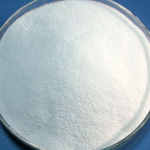Project Description
Sodium Tripolyphosphate
 Synonyms: Pentasodium tripolyphosphate; STPP; Pentasodium triphosphate
Synonyms: Pentasodium tripolyphosphate; STPP; Pentasodium triphosphate
Molecular formula: Na5O10P3
Molecular weight: 367.86
INS Number: E450(i)
CAS Number:7758-29-4
Einecs Number: 231-838-7
Properties: White powder; Melting point: 622℃; It can chelate metal ions, such as calcium, magnesium, etc., soften hard water, and has the characteristics of a surface-promoting agent of organic matter.
Specification :
| Item | Food grade |
|---|---|
| Content (Na5P3O10) | 95.0%min. |
| Phosphorus pentoxide | 56.0-59.0% |
| Water-insoluble | 0.05%max. |
| PH value (1% water solution) | 9.5-10.0 |
| Heavy metal (Pb) | 0.001%max. |
| Arsenic (As) | 0.0001%max. |
| Fluoride (F) | 0.001%max. |
| Cadmium (Cd) | 0.0001%max. |
| Mercury (Hg) | 0.0001%max. |
| Iron (Fe) | 0.01%max. |
| Loss on drying | 0.7%max. |
Application:
Sodium tripolyphosphate (STPP) has several applications across various industries.
1. In food processing:
Sodium tripolyphosphate (STPP) is a food additive in various processed products such as meat, seafood, and poultry. It helps improve processed meats’ water-holding capacity, texture, and juiciness.
- Moisture retention: STPP is often added to processed meats, such as ham, sausages, and seafood products, to improve their water-holding capacity. This helps to enhance the juiciness, tenderness, and overall texture of these products.
- Texture improvement: STPP can also be used to modify the texture of processed meats, making them more succulent and reducing the likelihood of a dry or rubbery texture during cooking or processing.
- pH control: STPP acts as a pH regulator, helping maintain the desired acidity or alkalinity level in certain food products. It can be used in canned meats and seafood, where maintaining the proper pH is vital for food safety and preservation.
- Emulsification and stabilization: STPP has emulsifying properties and can stabilize the emulsions in certain food products. This is particularly important in processed meats and seafood, where STPP assists in creating stable emulsions and preventing the separation of the ingredients.
- Shelf life extension: STPP is sometimes used as a preservative to extend the shelf life of certain food products. By inhibiting the growth of bacteria and other microorganisms, it helps extend the freshness and quality of the food.
2. In water treatment: Sodium tripolyphosphate (STPP) is used as a sequestering agent to prevent the formation of scale and deposits caused by hard water minerals. It helps in maintaining the effectiveness and efficiency of water treatment processes.
3. Ceramic industry: Sodium tripolyphosphate (STPP) is used as a dispersant in the ceramic industry to improve the workability of ceramic slurries, control rheological properties, and enhance the firing properties of ceramic products.
4. Detergents and cleaning products: Sodium tripolyphosphate (STPP) is commonly used in laundry detergents and cleaning products due to its ability to soften water, prevent the deposition of dirt and stains on fabrics, and enhance the cleaning performance.
5. Oil drilling: Sodium tripolyphosphate (STPP) has applications in the oil drilling industry for effectively stabilizing oil well drilling mud, controlling viscosity, and inhibiting corrosion.
6. Industrial applications: Sodium tripolyphosphate (STPP)is used in various industrial applications, including metal surface treatment, textile processing, paper manufacturing, and fire retardants.
For more details, please visit What Is Pentasodium Triphosphate?
Packing: In PP+PE bags of 25kgs net each, we can provide packages according to the customer’s requirement.
Storage: Store at a cool, dry, and well-ventilated place.
Shelf life: 24 months.

